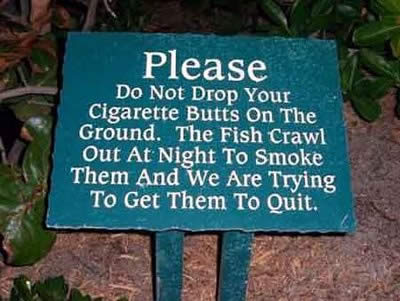In the study The Effect of Humor on Advertising Comprehension they find that “Prior investigations of the impact of humor on advertising message comprehension have generally found humorous commercials to be no more effective than comparable serious messages. This study re-examines humor’s influence by focusing on type of humor measurement (manipulated vs. perceived) and humor location in the advertisement. Findings indicate that humor (in the form of a one-line joke) does promote message comprehension, and offer support for information processing and operant conditioning explanations of the humor influence process.” At the bottom of the page you’ll find the article in its entirety. But for now, let’s enjoy those using humor to get their messages heard. Enjoy and please send in yours using the form at the bottom of the page.
That’s the slide show, but if you’d rather skip around, you’ll find all the images in a grid down below. Keep all of yours coming and we’ll add them to the list here. If we get a ton of submissions, we’ll separate them by animal, or by some other logical order so you can find what you’r looking for.
ALL THE IMAGES
Below you’ll find the FULL copy from the Association for Consumer Research page:
The Effect of Humor on Advertising Comprehension
ABSTRACT – Prior investigations of the impact of humor on advertising message comprehension have generally found humorous commercials to be no more effective than comparable serious messages. This study re-examines humor’s influence by focusing on type of humor measurement (manipulated vs. perceived) and humor location in the advertisement. Findings indicate that humor (in the form of a one-line joke) does promote message comprehension, and offer support for information processing and operant conditioning explanations of the humor influence process.
Advances in Consumer Research Volume 11, 1984 Pages 432-437
THE EFFECT OF HUMOR ON ADVERTISING COMPREHENSION
Calvin P. Duncan, University of Colorado, Boulder
James E. Nelson, University of Colorado, Denver
Nancy T. Frontczak, University of Colorado, Denver
[This work was supported in part by a grant from the College of Business and Administration Faculty Research Fund, University of Colorado.]
ABSTRACT
Prior investigations of the impact of humor on advertising message comprehension have generally found humorous commercials to be no more effective than comparable serious messages. This study re-examines humor’s influence by focusing on type of humor measurement (manipulated vs. perceived) and humor location in the advertisement. Findings indicate that humor (in the form of a one-line joke) does promote message comprehension, and offer support for information processing and operant conditioning explanations of the humor influence process.
INTRODUCTION
Examination of broadcast and print advertising suggests that humor is a widely accepted form of commercial appeal. In television, for example, it is estimated that some element of humor can be found in up to 20 percent of all commercial spots (Cantor 1976; Kelly and Solomon 1975). Radio’s use of humorous advertising is similarly pervasive (Lubalin 1977). Underlying this popularity is the belief that humor improves advertising effectiveness. Of obvious interest to advertisers and agencies alike is whether the presumed positive impact is supported on both theoretical and empirical grounds. To evaluate this assumption properly, empirical investigations must (1) address specific communication goals, (2) draw from theories that describe the humor influence process, and (3) operationalize humor to account for individual differences. This paper discusses each of these requirements and reports relevant findings from an empirical study on humorous advertising effects.
Communication Goals
While communication goals of humor-laden commercials may be stated in terms of any stage of McGuire’s (1969) information processing model, they typically focus on comprehension and persuasiveness (Sternthal and Craig 1973). Published findings on humor’s effect on persuasiveness have generally shown humorous messages to be no more effective than serious versions of the same communication (Brooker 1981; Kennedy 1972; Kilpela 1961; Lull 1940; Pokorney and Gruner 1969). In contrast, Delozier (1976, p. 105) notes a general effect of humor in gaining attention to an advertising message and in enhancing comprehension and subsequent recall. Thus, to the extent that humor is positively perceived, its presence may be expected to aid the learning of advertising content. While previous studies have failed to substantiate Delozier’s position (Cantor and Venus 1980; Gruner 1965; Markiewicz 1972; Murphy et al. 1979; Taylor 1964), serious questions can be raised about the generalizability of these results. Cantor and Venus (1980) point out that the type of humor (satire) manipulated in several of these studies is inappropriate for mass market advertising. In addition, the studies have not controlled for the degree to which individual subjects perceived communications to be humorous.
Thus, still unresolved is whether humor can improve audience comprehension and subsequent recall of a commercial message. Missing also is an empirical test of alternative theoretical frameworks available to explain humor’s hypothesized influence.
Theory
By what process can humor affect advertisement learning and comprehension? Two theoretical frameworks appear relevant (Cantor and Venus 1980; Peter and Nord 1982; Phillips 1968), each postulating a different mechanism to explain humor’s influence. Information processing theory assumes a consumer who makes decisions following the acquisition, integration, and evaluation of information (Bettman 1979; Zaltman and Wallendorf 1983). In terms of McGuire’s model (1969), humor’s potential for improving message comprehension depends on its ability to first stimulate audience attention and learning. Two explanations support humor’s influence on this hypothesized attention _ learning _ comprehension sequence. Helson’s adaptation-level paradigm argues that stimuli will attract attention when perceived as different from previously established stimulus norms (Helson 1947, 1959). Thus, humor unique to an advertising context (e.g., product category or sponsor) or perceived as exceptional will be noticed. Unique advertisements in general are learned and remembered better than ordinary commercials (DeLozier 1976, p. 65). Also pertinent to humor’s influence on message attention and comprehension is its role in shaping the listener’s “reception environment” during advertising exposure (Tyebjee 1978). As defined by Tyebjee, the reception environment “is represented in terms of the level and type of arousal it engenders in the receiver and the opportunity it provides to process message stimuli” (p. 174). Humor that generates “arousal to process information” should stimulate comprehension and recall.
Operant conditioning theory offers an alternative explanation for humor’s effect. Operant conditioning “has occurred when the probability that an individual will emit one or more behaviors is altered by changing the events or consequences which follow the particular behavior” (Nord and Peter 1980, p. 38). Unlike information processing theory, operant conditioning views humor as a reward for listening to the advertising message (Phillips 1968). A humorous, and therefore rewarding, advertisement should be better understood and recalled than a similar non-humorous advertisement. Kassarjian (1977) and Rothschild and Gaidis (1981) have argued for the application of operant learning principles to explain advertising effects in low involvement settings. As yet, however, operant learning has not been adopted to explain the impact of commercial humor.
Perception of Humor
Perception of humor is personal: what is funny to one individual can be uninteresting or even irritating to another. Earlier marketing studies have not measured humor as a perceived variable, however. [An exception is Gelb and Pickett (1983).] Instead, experimenters (e.g., Cantor and Venus 1980; Murphy et al. 1979; Shama and Coughlin 1979) have attempted to control degree of humor, using panels of Judges (researchers or advertising professionals) to select the humorous commercials employed in their investigations. Though manipulation checks are made to ensure that humorous treatments are rated as funnier than serious versions of the same advertisement, experimenters have implicitly assumed that all subjects exposed to a given humorous commercial will perceive it as equally amusing. The present study questions this assumption by reporting results separately for manipulated and perceived humor.
PURPOSE
This study addresses the following research questions:
- Does humor increase audience comprehension of a commercial message?
- If humor is effective, what is the mechanism that explains its effect?
- Is there a best location for humor in a commercial?
- Do research results change when measures of perceived humor are substituted for measures of manipulated humor?
- When attempted humor fails, what is its influence on message comprehension and recall?
METHOD
Humor Stimulus and Commercial Message
To be effective in an advertising context, humor must be geared to communication goals, nature of the product, selected media, target audience, and message complexity. Duncan (1979) suggests that sophisticated forms of humor (e.g., satire, irony, puns) may be inappropriate for informational commercials containing multiple selling points. Stansfield (1969) argues for pertinent rather than extraneous humor. Humor used in this research followed both guidelines. A one-line joke was integrated into a 60-second radio commercial for a hypothetical new men’s hair care product called “New Wave.” The advertisement was written by a professional copy writer and produced at a local television station.
The basic commercial was administered in four different versions, as part of a single factor, after-only experimental design (each version being an experimental treatment). Each version contained four primary selling propositions (PSPs) presented in this order:
1. New Wave makes men attractive to women.
2. New Wave is safe to use.
3. New Wave has been tested by over 100 men’s hair stylists.
4. New Wave is sold only in better stores and hair salons.
Each of the four versions was the same in factual content and approximate length, but different in structure. Version A (reproduced in the Appendix) presented the humor stimulus first, followed by each of the four PSPs. Version B introduced the humorous stimulus after presentation of the first three PSPs but before the fourth.
Version C was identical to B except that subjects heard all four PSPs before exposure to the humor. Version D, the serious version, was worded and structured to be identical to C except that the one-line joke was deleted. This omission caused the fourth version to be 12 seconds shorter than the other three.
The four commercial versions are useful in evaluating information processing and operant conditioning as competing theoretical explanation’s of humor’s effect on comprehension. Rumor at the beginning of a commercial (version A) or before at least one PSP (version B) is consistent with an information processing explanation. By gaining audience attention and stimulating “arousal to process information,” humor should lead to greater comprehension of the information that follows. On the other hand, operant conditioning presumes a humor-after sequence. Humor following the presentation of one or more PSPs (versions B and C) should reward audience members for listening and thereby improve their understanding and subsequent recall of presented material. [This study uses aided recall of (three) specific PSPs as a measure of message comprehension. Because each PSP is brief and simply stated, it is quite likely that recall reflects message comprehension. In other advertising settings, such as print advertisements with extensive information content, recall of PSPs may be a poor measure of comprehension. See Jacoby and Hoyer (1982) for an alternative measure of comprehension/ miscomprehension.]
One hundred and fifty-seven male undergraduates enrolled at a large Western university completed the experiment during a three day period. Student subjects were used because they represented a primary target market for the advertised product.
At scheduled 45 minute intervals, participants arrived at a classroom adjacent to the behavioral laboratory where the experiment was conducted. They received a page of preliminary instructions introducing the study and requesting subjects to refrain from talking to each other while waiting for the experiment to begin. Individual subjects were then taken to one of six, randomly assigned, listening rooms. Each subject was seated at a desk located directly below a ceiling speaker, adjusted to the same tone and volume as speakers in other rooms. Printed instructions on the desk informed subjects that approximately 15 minutes of pre-recorded radio programming would soon begin. Instructions also told subjects to relax and listen to the programming as if they were at home or in their car. The recorded programming itself contained spliced excerpts of actual radio broadcasts, including a professional announcer who introduced each musical selection and coordinated the components of the broadcast.
An experimenter in a master control room initiated all programming. Tapes began and ended simultaneously in each listening room and were identical except for the four versions of the New Wave commercial (hereafter referred to as treatment A, treatment B, treatment C, and treatment D). Presentation of programming content followed this sequence:
When programming ended, subjects received a questionnaire and answered six open-ended questions, one measuring unaided recall of the four PSPs. These questions were followed by 39 nine-point Likert statements that measured, among other variables, perceived humor. (For disguisement purposes, the questionnaire included several open-ended questions and Likert statements concerning purchase preferences and various aspects of radio programming.) Questionnaire items 20, 23, and 31 measured perceived humor.
20. The man in the New Wave commercial was funny.
23. The New Wave commercial was more serious than it was funny.
31. Most men would not find the New Wave home permanent commercial to be humorous.
The questionnaire ended with three aided recall questions (open-ended) associated with PSPs 1, 3, and 4.
At the conclusion of the experiment, selected subjects were debrief ed to determine if they had guessed the purpose of the research. Subjects then signed a payment voucher and were requested not to discuss the experiment for three full days.
RESULTS
Preliminary
Results of the debriefing process indicated that subjects did not guess the purpose of the study. However, it was necessary to remove eight subjects from data analysis because of response deficienciesCeither large numbers of item non-response to the Likert statements or an extreme tendency to select a neutral response. Responses for the remaining 149 subjects produced a coefficient alpha for the perceived humor scale o f O . 66 . The two judges scoring the aided recall responses (as either correct or incorrect) produced a composite reliability coefficient (Holsti 1969, p. 137 ) of 0.89. Convergent validity of the aided recall dependent variable was supported by a correlation of .61 between the aided recall and unaided recall measurements
Manipulated Humor
Tables 1 and 2 summarize aided recall results by treatment, i . e., by manipulated humor . Results in Table 1 appear to support neither information processing nor operant 3 earning theory, a point confirmed by the two analyses of variance summarized in Table 2. Consistent with earlier research, data in Table 2 show no significant differences between means for tests indicated by the theories.
AIDED RECALL OF PSPs BY TREATMENT
Perceived Humor
However, analyses in Tables 1 and 2 are suspect from the point of failing to consider humor as perceived by individual subjects. Quite likely some subjects saw more humor in the commercial than did others. Table 3 supports this contention, showing diversity in subject responses to the self-report measure of humor. Clearly, the attempt at humor worked for some subjects in treatments A, B, and C but failed for others. Of equal note, is the perception by a few subjects of some little humor in treatment D.
Because subjects perceived varying degrees of humor, additional analysis would seen warranted. In particular, aided recall scores for subjects who perceived their commercial as particularly humorous in treatments A, B, and C might be compared with scores for subjects in treatment D who saw their commercial as distinctly not humorous. Table 4 summarizes results, showing market differences from the aided recall values presented in Table 1.
AIDED RECALL OF PSPs BY TREATMENT, REDUCED SAMPLE
Results of ANOVAs testing each theory appear in Table 5 and support both theories almost equally. For information processing and operant conditioning analyses, respectively, values for eta squared are .18 and .20 for the relationship between perceived humor and aided recall. As a further indication of equal support, a simple t-test between mean recall scores for treatments A and C shows no significant difference (t = 0.60, p <.56).
Finally, reference to Table 3 suggests a last analysis on recall scores for subjects m treatments A, B, and C. As Table 3 indicates, the attempt at humor failed for many subjects. If the theoretical relationships noted above are robust, recall scores for these subjects should be significantly lower than scores for subjects in these treatments who thought the commercial humorous. Table 6 presents results of two t-tests undertaken to examine this issue, the first using slightly more liberal definitions than the second in identifying which subjects belong to the successful and unsuccessful groups. Both tests show significant results, consistent with those reported earlier.
AIDED RECALL FOR SUCCESSFUL, UNSUCCESSFUL HUMOR GROUPS (TREATMENTS A, B, AND C)
DISCUSSION AND CONCLUSIONS
Findings contradict earlier studies reporting little or no effect of humor on advertising comprehension. Taken together, Tables 3 through 6 show strong support for a perceived humor- aided recall relationship. The ratio of mean recall scores for high perceived humor groups to mean recall scores for low perceived humor groups is roughly from 1.5 to 2.1:1 (depending on groups involved in the analysis). One explanation for the discrepancy between these and previous findings is that prior investigations failed to account for individual differences in humor tastes. This conclusion finds support in the comparison of manipulated humor effects (Table 2) with perceived humor effects (Table 5).
If humor does improve commercial comprehension, what is the underlying mechanism that explains its effect? Both the information processing and operant conditioning explanations receive support; that is, humor before PSPs and humor after PSPs appear equally effective. Further testing of both paradigms is needed to confirm or refute either theory as the basis for humor’s effect on comprehension. Such research should investigate the effect of repeated exposures on the efficacy of the two theories. The cross-sectional nature of this study provides only a weak test of the operant conditioning paradigm which links probability of response with a schedule of reinforcement. One might anticipate that late humor’s reinforcing effect on attention would increase as advertising exposures increase,to a point. Future research might also employ physiological measures of attention and perceived humor as alternatives to the self report procedure used here.
Study findings indicate that even when attempted humor fails, it promotes recall as well as does a serious version of the same advertisement. This unexpected finding raises additional questions. What is the nature of the cognitive response elicited by failed humor? It is possible that unsuccessful humor distracts and, in some instances, irritates target listeners. Irritation, in turn, may lead to consumers disliking the advertisement and, ultimately, the product itself. Bartos (1981) notes the absence of research linking advertising irritation with brand image. However, Mitchell and Olson (1981) show that attitude toward an advertisement (part of which was a measure of irritating-not irritating beliefs) mediates advertising effect on brand attitudes. Further, Greyser (1973) and Gelb and Pickett (1983) report that liking of an advertisement is a strong influence on liking of the product and product use.
Future research needs to establish if unsuccessful humor attempts produce irritation among large segments of target audiences. If this irritation exists, how does it influence commercial effectiveness? Two general hypotheses might provide direction. Greyser suggests that “very pleasant and very unpleasant ads are more effective than those in between.” A competing hypothesis of interest is that irritation might work well for achieving lower order communications objectives (attention, recall) but be negatively associated with higher order effects (attitude change, intention to buy, purchase).
APPENDIX
Copy for version A follows:
ANNCR: Introducing New Wave. The new home permanent for a man ‘ s; hair .
MAN: (One man, trying to stifle a laugh. Like an internal build up, until the man lets out a laugh. He still tries to stifle). With this home permanent, do I use it before, or after I put on my pantyhose? (Laughter fades).
WOMAN: Rodney. First I loved him for his hair. Then I loved him. If it weren’t for his hair, I wouldn’t have noticed him in the first place.
MAN: Ah, yeah, what was the name of that men’s home permanent?
ANNCR: New Wave. New Wave will make you look the way you always wanted to look: Good to women. New Wave is guaranteed safe. It’s been tested and approved by more than 100 professional men’s hair stylists. It’s available only at finer stores and hair care shops. New Wave. The new home permanent for a man’s hair.
REFERENCES
Baron, R., P. Baron, and N. Miller (1973), “The Relation Between Distraction and Persuasion,” Psychological Bulletin, 80, 310-23.
Bartos, Rena (1981), “Ads That Irritate May Erode Trust in Advertised Brands,” Harvard Business Review, 59 (July-August), 138-140.
Bettman, James R. (1979), An Information Processing TheorY of Consumer Choice, Reading, MA: Addison-Wesley Publishing Company.
Bither, Stewart W. (1972), “Effects of Distraction and Commitment on the Persuasiveness of Television Advertising,” Journal of Marketing Research, 9 (February) 1-5.
Brooker, George (1981), “A Comparison of the Persuasive Effects of Mild Humor and Mild Fear Appeals,” Journal of Advertising, 10, 29-40.
Cantor, Joanne (1976), “Humor on Television: A Content Analysis,” Journal of Broadcasting, 20 (Fall), 501-10.
Cantor, Joanne and Pat Venus (1980), “The Effect of Humor on Recall of a Radio Advertisement,” Journal of Broadcasting, 24 (Winter), 13-22.
DeLozier, M. Wayne (1976), The Marketing Communications Process, New York: McGraw-Hill Book Company.
Duncan, Calvin P. (1979), “Humor in Advertising: A Behavioral Perspective,” Journal of the Academy of Marketing Science, 7 (Fall), 285-306.
Festinger, Leon and Nathan Maccoby (1964), “On Resistance to Persuasive Communication ,” Journal of Abnormal and Social Psychology, 68 (November), 359-66.
Gardner, David M. (1970), “The Distraction Hypothesis in Marketing,” Journal of Advertising Research, 10 (December). 25-30.
Gelb, Betsy D. and Charles M. Pickett (1983), “Attitude-Toward-The-Ad: Links to Humor and to Advertising Effectiveness,” Journal of Advertising, 12, 2, 34-42.
Greyser, Stephen A. (1973), “Irritation in Advertising,” Journal of Advertising Research, 13, 3-10.
Gruner, Charles R. (1965), “An Experimental Study of Satire as Persuasion, Speech Monographs, 32 (June), 149-54.
Helson, H. (1947), “Adaptation-Level as a Frame of Reference for Prediction of Psychophysical Data,” American Journal of Psychology, 60, 1-29.
Helson, H. (1959), “Adaptation-Level Theory,” in Psychology: A Study of a Science. I. Sensory Perception and Physiological Formulations, New York: McGraw-Hill Book Company.
Holsti, Ole R. (1969), Content Analysis for the Social Sciences and Humanities, Reading, MA: Addison-Wesley Publishing Company.
Jacoby, Jacob and Wayne Hoyer (1982), “Viewer Miscomprehension of Televised Communication: Selected Findings,” Journal of Marketing, 46 (Fall), 12-26.
Kassarjian, H.H. (1978), “Presidential Address, 1977: Anthropomorphism and Parsimony,” in Advances in Consumer Research, Vol. 5, H. R. Hunt, ed ., Ann Arbor, MI: Association for Consumer Research, xii-xiv.
Kelly , J. Patrick and Paul J. Solomon (1975), “Humor in Television Advertising, Journal of Advertising, 4 (Summer), 31-5.
Kennedy, A. J. (1972), “An Experimental Study of the Effect of Humorous Message Content Upon Ethos and Persuasiveness,” unpublished Doctoral Dissertation,, University of Michigan.
Kilpela, D.E. (1961), “An Experimental Study of the Effects of Humor on Persuasion,” unpublished Master’s Thesis, Wayne State University.
Lubalin, Peter (1977), “Humor in Radio,” ANNY, (November), 22.
Lull, P.E. (1940), “The Effectiveness of Humor in Persuasive Speech,” Speech Monographs, 7 (December), 26-40.
Markiewicz, Dorothy (1972), “The Effects of Humor on Persuasion,” unpublished Doctoral Dissertation, The Ohio State University.
McGuire, William J. (1969), “An Information-Processing Model of Advertising Effectiveness,” paper presented at the Behavioral and Management Science in Marketing Symposium, University-of Chicago, June 29-July 1.
Mitchell, Andrew A. and Jerry C. Olson (1981), “Are Product Attribute Beliefs the Only Mediator of Advertising Effects on Brand Attitude?,” Journal of Marketing Research, 18 (August 1981), 318-32.
Murphy, John H., Isabella C.M. Cunningham, and Gary B. Wilcox (1979), “The Impact of Program Environment on Recall of Humorous Television Commercials,” Journal of Advertising, 8 (Spring). 17-21.
Nord, Walter R. and J. Paul Peter (1980), “A Behavioral Modification Perspective on Marketing,” Journal of Marketing, 44 (Spring), 36-47.
Peter, J. Paul and Walter R. Nord (1982), “A Clarification and Extension of Operant Conditioning Principles in Marketing,” Journal of Marketing, 46 (Summer), 102-107.
Phillips, Kalman (1968), “When a Funny Commercial Is Good, It’s Great.’,” Broadcasting, 74 (May 13), 26.
Pokorny, G.F. and Charles R. Gruner (1969), “An Experimental Study of the Effect of Satire Used as Support in Persuasive Speech,” Western Speech, 33 (Summer), 204-11.
Rothschild, Michael L. and William C. Gaidis (1981), “Behavioral Learning Theory: Its Relevance to Marketing and Promotions,” Journal of Marketing, 45 (Spring), 70-78.
Shama, Avraham and Maureen Coughlin (1979), “An Experimental Study of the Effectiveness of Humor in Advertising,” in 1979 Educators’ Conference Proceedings, N. Beckwith et al., eds., Chicago: American Marketing Association.
Stansfield, Richard H. (1969), Advertising Manager’s Handbook, Chicago: The Dartnell Corporation, 670.
Sternthal, Brian and C. Samuel Craig (1973), “Humor in Advertising,” Journal of Marketing, 37 (October), 12-18.
Taylor, P.M. (1964), “The Effectiveness of Humor in Informative Speeches,” Central States Speech Journal, 15 (November). 295-96.
Tyebjee, Tyzoon T. (1978), “Cognitive Response and the Reception Environment of Advertising,” in Research Frontiers in Marketing: Dialogues and Directions, ed. S.C. Jain, Chicago: American Marketing Association, 174-77.
Zaltman, Gerald and Melanie Wallendorf (1983), Consumer Behavior, New York: John Wiley and Sons, 328.




















































































